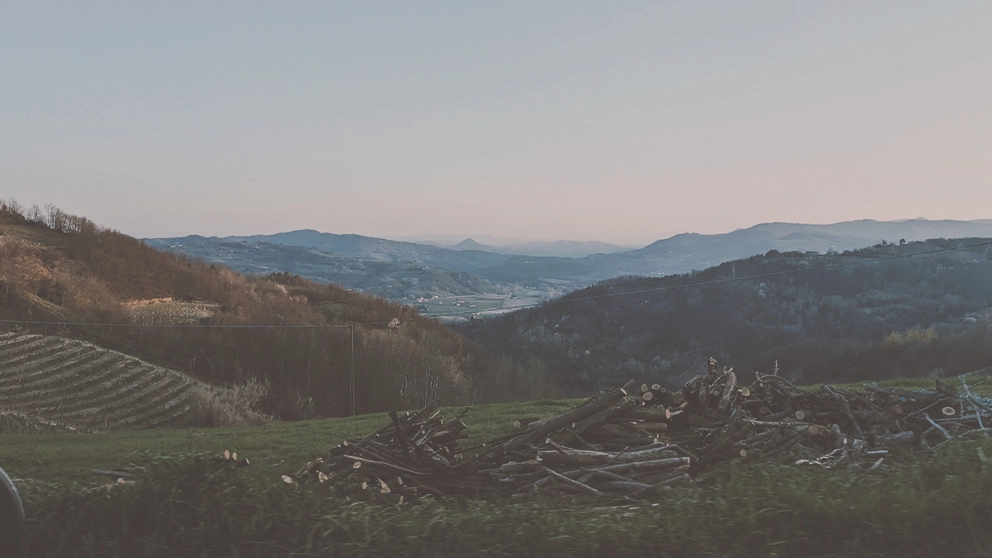Exploring the tradition of biomass heating in Piedmont, a listening journey in search of connections between identity, sustainability and the future of biofuel consumption.

The qualitative research project
In the heart of the majestic lands of Piedmont, where hills merge with plains and forests stand like silent guardians, the issue of biofuel consumption turns out to be a vitally important one.
The activity described here is part of a project in the field of UX and qualitative research in collaboration with Piedmont Region in which TSW’s Research Team embarked on an exploratory journey of the territory, conducting narrative interviews in different locations in the region.

The goal of the project is to fully understand people’s habits and perceptions regarding the use of wood and pellets as heat sources. The project aims to collect data on two main fronts: the composition of the biomass plant and the behaviors adopted by users in using wood fuels.
With the aim of providing valuable insights to optimize processes and reduce the environmental impact of such fuels, a mixed methodology is used that includes both quantitative and qualitative investigations.
The essence of TSW lies in the deep care for the human connection that develops with people. Based on this principle, the Research Team did not simply collect answers to specific questions, but rather established an open dialogue, allowing people to tell why they made certain choices. In this way, it was able to capture the subtle nuances that only an authentic human relationship can reveal.
In analyzing the experience, since Piedmont is known to be an expression of very different cultural areas, various elements were also taken into consideration, including the size of the town where people were interviewed, its altitude and the number of inhabitants.
Context and diversity of the Piedmont
Biomass is one of the most widely adopted renewable energy sources in Piedmont, with a significant contribution to heat production estimated at around 650 thousand tons of oil equivalent. This resource is widely used by Piedmont households to meet a substantial part of their thermal needs in the residential sector.
With its vast expanse, rich forest cover, and cultural diversity, the Piedmont presents a unique canvas for examining home heating practices. From alpine areas to hilly and flat landscapes, each area offers a different perspective, influenced by climatic, geographic, and cultural factors.

Stocking up with wood becomes a gesture imbued with deep meanings: wood heating, in fact, goes beyond the simple function of heat, representing an element of cohesion, identity and domestic tradition.
Those who choose this solution often take pride in their independence and see collecting wood as an act of autonomy and strength. But there is more: the gesture can also be interpreted as a contribution to forest cleanup and conservation, an action that resonates with a sense of responsibility to the surrounding environment.
Moreover, the return to the ancient practices related to the use of wood can evoke an intertwining of nostalgic feelings related to a past steeped in simplicity and authenticity. Memories of grandma’s cooking meals on the stove and the enveloping warmth of burning wood instantly transport one to a time when life flowed at a slower pace and happy moments were imbued with a sense of authenticity.
These memories often weave a deep connection with people’s roots and offer them a rare opportunity to reconnect with a dimension of existence that is often forgotten in the modern age where technology and haste prevail.
In mountain communities, moreover, the practice of fire is often not only considered a necessity to cope with the climatic rigors, but also represents a tribute to previous generations and knowledge passed down through time. Thus, the ritual associated with the gathering and preparation of wood is configured not only as a practical gesture, but as an experience that nurtures a sense of identity and continuity with the past, enriching the social and cultural fabric of mountain communities.
How much does the tension between a thousand-year-old dynamic that belongs to the villages, the hamlets, the Alpine and hilly context, affect this, compared to the more recent environmental and ecological sensitivity? What is, after all, the true widespread perception and how does it vary according to the level of education, exposure to cultural consumption, the availability of alternative heating sources?
Future perspectives
The results collected will provide an insightful look at the dynamics of biofuel consumption in Piedmont, shedding light on cultural, environmental and economic aspects. The information may serve as a solid basis for future interventions aimed at promoting more sustainable and responsible combustion practices. It is a call to reflection and action so that Piedmont can continue on its path toward a greener and more prosperous future for generations to come.